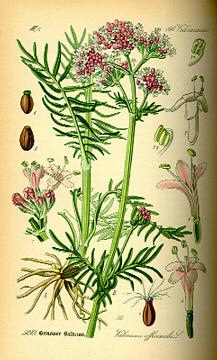

Zitierweise / cite as:
Carakasaṃhitā: Ausgewählte Texte aus der Carakasaṃhitā / übersetzt und erläutert von Alois Payer <1944 - >. -- Anhang A: Pflanzenbeschreibungen. -- Nardostachys grandiflora DC. -- Fassung vom 2007-06-27. -- URL: http://www.payer.de/ayurveda/pflanzen/nardostachys_grandiflora.htm
Erstmals publiziert: 2007-06-27
Überarbeitungen:
Anlass: Lehrveranstaltung SS 2007
©opyright: Dieser Text steht der Allgemeinheit zur Verfügung. Eine Verwertung in Publikationen, die über übliche Zitate hinausgeht, bedarf der ausdrücklichen Genehmigung des Verfassers
Dieser Text ist Teil der Abteilung Sanskrit von Tüpfli's Global Village Library
WARNUNG: dies ist der Versuch einer
Übersetzung und Interpretation eines altindischen Textes. Es ist keine
medizinische Anleitung. Vor dem Gebrauch aller hier genannten Heilmittel wird
darum ausdrücklich gewarnt. Nur ein erfahrener, gut ausgebildeter ayurvedischer
Arzt kann Verschreibungen und Behandlungen machen!
Falls Sie die diakritischen Zeichen nicht dargestellt bekommen, installieren Sie eine Schrift mit Diakritika wie z.B. Tahoma.
Verwendete und zitierte Werke siehe: http://www.payer.de/ayurveda/caraka0001.htm

Abb.: Nardostachys grandiflora
DC. — Nardenähre (Speichenähre)
[Bildquelle: Wikipedia]
Dutt:
"NARDOSTACHYS JATAMANSI, D C. Syn. Valeriana Jatamansi, Jones.
Sans. Jatāmānsi. Vern. Jatāmānsi, Beng. Bāluchar, Hind.
The Nardostachys Jatamansi is a native of the mountains of Northern India and has been used in Hindu medicine from a very ancient period. The fragrant root is considered a nervine tonic, and is much used as an aromatic adjunct in the preparation of medicinal oils and ghritas. It does not appear however to have been used internally except as an ingredient of complex prescriptions. In the Pharmacopoeia of India it is stated that Jatāmānsi enters into the composition of a nostrum highly recommended in the treatment of epilepsy by Susruta. I do not find in Susruta's work any prescription for epilepsy, containing jatāmānsi, except the following, in which however it can hardly be said to be an active ingredient. Take of the pulse of Phaseolus Roxburghii ( kulattha ), barley, jujube fruit, seeds of Crotolaria juncea (sana), bdellium, jatāmānsi root, the ten drugs collectively called dasamula ( see Desmodium gangeticum ), and chebulic myrobalan, equal parts ; and prepare a decoction in the usual way. This decoction is recommended to be administered with the addition of clarified butter and goat's urine."
[Quelle: Dutt, Uday Chand: The materia medica of the Hindus / Uday Chand Dutt. With a glossary of Indian plants by George King. -- 2. ed. with additions and alterations / by Binod Lall Sen & Ashutosh Sen. -- Calcutta, 1900. - XVIII, 356 S. -- S. 180.]